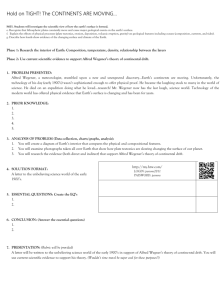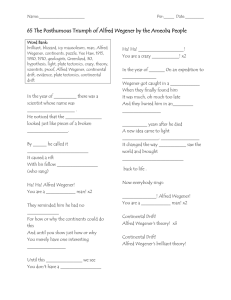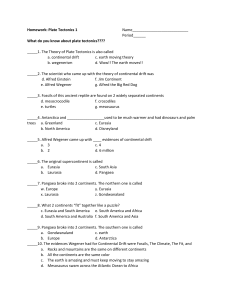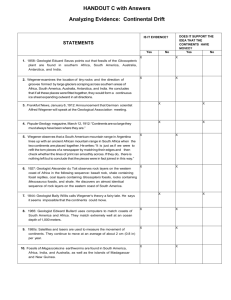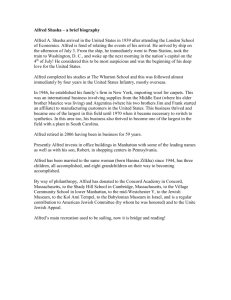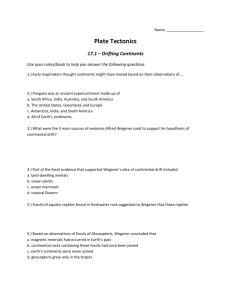Continental Drift
advertisement
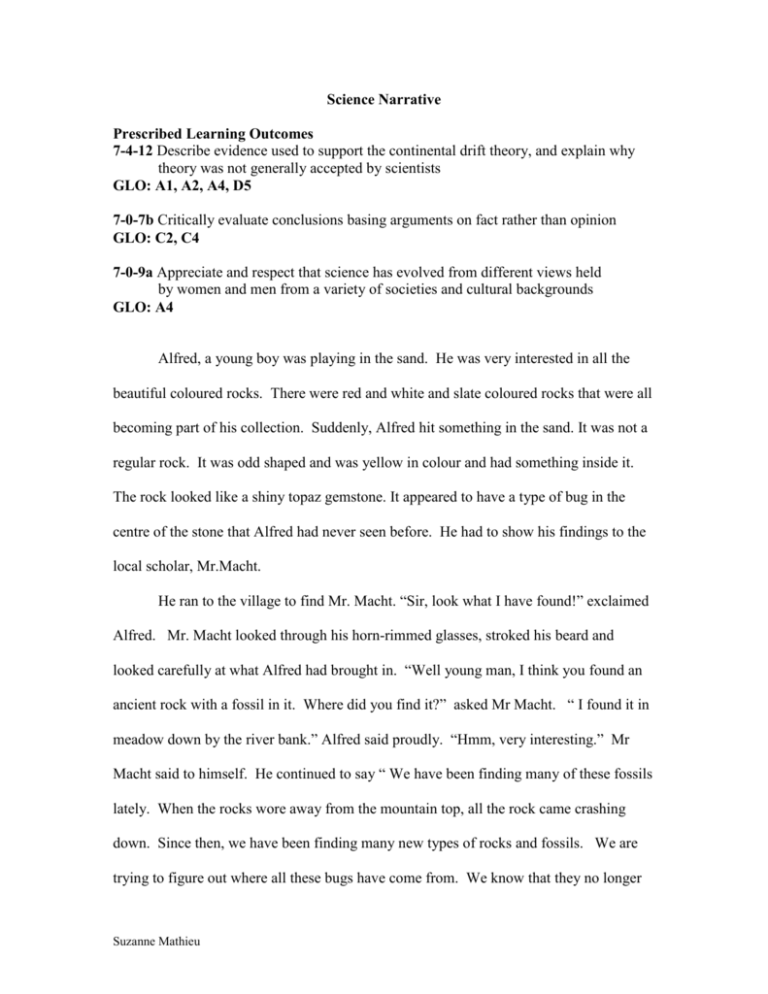
Science Narrative Prescribed Learning Outcomes 7-4-12 Describe evidence used to support the continental drift theory, and explain why theory was not generally accepted by scientists GLO: A1, A2, A4, D5 7-0-7b Critically evaluate conclusions basing arguments on fact rather than opinion GLO: C2, C4 7-0-9a Appreciate and respect that science has evolved from different views held by women and men from a variety of societies and cultural backgrounds GLO: A4 Alfred, a young boy was playing in the sand. He was very interested in all the beautiful coloured rocks. There were red and white and slate coloured rocks that were all becoming part of his collection. Suddenly, Alfred hit something in the sand. It was not a regular rock. It was odd shaped and was yellow in colour and had something inside it. The rock looked like a shiny topaz gemstone. It appeared to have a type of bug in the centre of the stone that Alfred had never seen before. He had to show his findings to the local scholar, Mr.Macht. He ran to the village to find Mr. Macht. “Sir, look what I have found!” exclaimed Alfred. Mr. Macht looked through his horn-rimmed glasses, stroked his beard and looked carefully at what Alfred had brought in. “Well young man, I think you found an ancient rock with a fossil in it. Where did you find it?” asked Mr Macht. “ I found it in meadow down by the river bank.” Alfred said proudly. “Hmm, very interesting.” Mr Macht said to himself. He continued to say “ We have been finding many of these fossils lately. When the rocks wore away from the mountain top, all the rock came crashing down. Since then, we have been finding many new types of rocks and fossils. We are trying to figure out where all these bugs have come from. We know that they no longer Suzanne Mathieu exist in this area. In fact, we do not know if they come from here.” Mr. Macht said. Alfred loved listening to Mr. Macht. He would talk as if he was thinking to himself, but Alfred always found these talks very interesting. Mr Macht later said “ According to my colleagues, similar fossils have been found in other lands. This does not make sense as there are greet oceans separating these lands. We do not know how these bugs and animals got from one place to another. This is what we are trying to figure out.” Alfred was amazed at what Mr.Macht had just told him. He could not believe that certain animals and bugs had once lived here but they no longer existed. How long ago did they live here? he thought. How are they in other lands when they are such large oceans separating these lands? Could they possibly swim or fly that far? These are questions that Alfred pondered. There must be an explanation. What could it be? Conclusion When Alfred Wegener grew up, he proposed a theory that explains why fossils that appear the same are found in different lands. He also wanted a more accurate time frame of when these fossils existed. Wegener noted a similarity in the shapes of the coastlines bordering the Atlantic Ocean. He predicated that all of the landmasses once formed a super-continent. He named this super-continent Pangaea. More than 200 million years ago, Pangaea broke apart and the continents have slowly drifted to their present positions. The idea came to be known as the Theory of Continental Drift. Some evidence that helped to support Wegener was that both South America and the Africa coastlines not only resembled one another geographically, many of the fossils of plants and animals were the same. He reasoned it was physically impossible for most of these plants and animals to have swam or been transported across the vast oceans. To Suzanne Mathieu him, the presence of identical fossil species along the coastal parts of Africa and South America was the most compelling evidence that the two continents were once joined. At the time Wegener introduced his theory, the scientific community firmly believed the continents and oceans to be permanent features on the Earth’s surface. Not surprisingly, his proposal was not well received, even through it seemed to agree with the scientific information available at the time. It was only later in the 1950’s that more evidence came to light to support Wegener’s theory. Big submarines and sonar radar were being using on the ocean floors. Using a variety of measurements, it was discovered that the earth’s ocean floor was constantly shifting and moving. This would explain why the continents were drifting apart. When more measurements were conducted, it was concluded that the lands were moving along many of the shifting plates on the bottom of the ocean floor. It would have appeared the Alfred Wegner’s theory was correct after all. Alfred had always been curious and through this, proposed a theory that is still accepted to this very day. Some questions that may help to answer the above questions 1. 2. 3. 4. Knowledge- List the seven major land masses or continents on earth. Comprehension- In your own words, explain Wegener’s theory Application- Why was this theory so important to science? Analysis- Use words from the text that best describe the Theory of Continental Drift. 5. Synthesis- Create a map with where the continents are now located. 6. Evaluation-What is the most important idea that is presented in this narrative? Suzanne Mathieu
